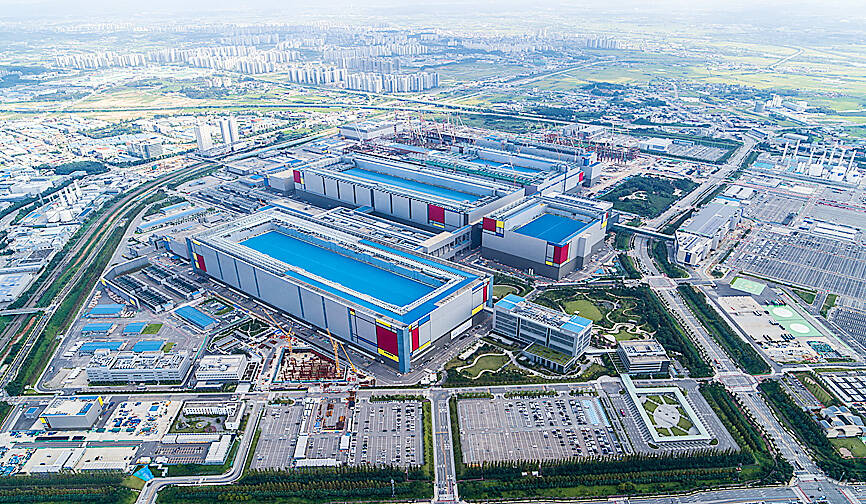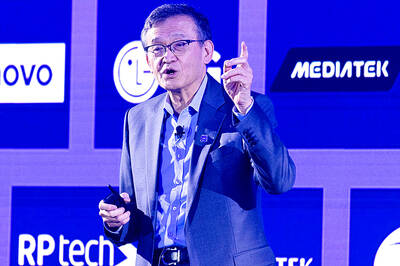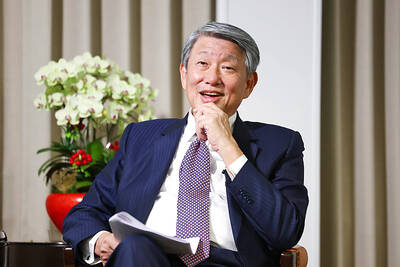South Korea’s parliament yesterday approved a bill to boost the country’s semiconductor industry by giving firms tax breaks to spur investments.
The legislation known as the K-Chips Act would increase the tax credit to 15 percent from the current 8 percent for major companies investing in manufacturing facilities, while the tax break for smaller and medium-size firms would go to 25 percent, up from the 16 percent.
The measure is expected to boost domestic investment for South Korean tech companies such as Samsung Electronics Co and SK Hynix Inc.

Photo: Reuters
The act had backing from lawmakers across party lines, with 179 members voting in favor and 13 opposed.
Nearly 40 lawmakers at parliament forfeited their vote, while nearly 70 did not take part in the ballot. South Korean President Yoon Suk-yeol has indicated he would approve the bill.
To prop up the economy and stand out in the global race for tech supremacy, Yoon early this month announced a US$422 billion investment into key areas such as chips and electric vehicles, including plans for hubs housing chipmaking plants.
With the new parliament bill and government incentives, Seoul is hoping to maintain its global semiconductor technology leadership or even overtake Taiwan when it comes to the business of making logic chips for others.
The tech sector is a major driver of South Korea’s trade-reliant economy, accounting for about 12 percent of total exports last month.
With global semiconductor demand in a slump, the economy contracted in the final three months of last year, and the current quarter also looks challenging as exports fall further.
Samsung and Hynix are the world’s two largest memorychip makers, while Samsung is the world’s second-largest contract manufacturer of logic chips by market share, trailing Taiwan Semiconductor Manufacturing Co (台積電).
Memory chips, which store data, are relatively simple and are traded like commodities. Logic chips, which run programs and act as the brains of a device, are more complex and expensive.
Adding to the pressure for South Korean chipmakers, US President Joe Biden’s administration is seeking help from its global partners to impose sweeping curbs on the sale of advanced chip equipment to China in a policy aimed at preventing the country’s progression in a range of cutting-edge technologies that could threaten the US’ status as the world’s pre-eminent power.
South Korean companies won a one-year reprieve from sweeping US export controls unveiled in October last year that prevent chipmakers from bringing in equipment for their advanced facilities in China. Without a license extension, it is unclear how Samsung and Hynix would proceed. Both depend on China as a key market and a manufacturing site for their memory chips.
Separately, the Biden administration announced so-called guardrails to restrict new investment for chip operations in China for companies that would get federal funds to build in the US.
The South Korean government has said the new restrictions would not prohibit technology upgrades at its chipmakers’ factories in China, adding that it is discussing the matter with US counterparts.
US politicians have said that they need to do more than just hold back China.
Last year’s CHIPS and Science Act would provide about US$50 billion of federal money to support US production of semiconductors and foster a skilled workforce for the industry.

Nvidia Corp CEO Jensen Huang (黃仁勳) today announced that his company has selected "Beitou Shilin" in Taipei for its new Taiwan office, called Nvidia Constellation, putting an end to months of speculation. Industry sources have said that the tech giant has been eyeing the Beitou Shilin Science Park as the site of its new overseas headquarters, and speculated that the new headquarters would be built on two plots of land designated as "T17" and "T18," which span 3.89 hectares in the park. "I think it's time for us to reveal one of the largest products we've ever built," Huang said near the

China yesterday announced anti-dumping duties as high as 74.9 percent on imports of polyoxymethylene (POM) copolymers, a type of engineering plastic, from Taiwan, the US, the EU and Japan. The Chinese Ministry of Commerce’s findings conclude a probe launched in May last year, shortly after the US sharply increased tariffs on Chinese electric vehicles, computer chips and other imports. POM copolymers can partially replace metals such as copper and zinc, and have various applications, including in auto parts, electronics and medical equipment, the Chinese ministry has said. In January, it said initial investigations had determined that dumping was taking place, and implemented preliminary

Intel Corp yesterday reinforced its determination to strengthen its partnerships with Taiwan’s ecosystem partners including original-electronic-manufacturing (OEM) companies such as Hon Hai Precision Industry Co (鴻海精密) and chipmaker United Microelectronics Corp (UMC, 聯電). “Tonight marks a new beginning. We renew our new partnership with Taiwan ecosystem,” Intel new chief executive officer Tan Lip-bu (陳立武) said at a dinner with representatives from the company’s local partners, celebrating the 40th anniversary of the US chip giant’s presence in Taiwan. Tan took the reins at Intel six weeks ago aiming to reform the chipmaker and revive its past glory. This is the first time Tan

CUSTOMERS’ BURDEN: TSMC already has operations in the US and is a foundry, so any tariff increase would mostly affect US customers, not the company, the minister said Taiwanese manufacturers are “not afraid” of US tariffs, but are concerned about being affected more heavily than regional economic competitors Japan and South Korea, Minister of Economic Affairs J.W. Kuo (郭智輝) said. “Taiwan has many advantages that other countries do not have, the most notable of which is its semiconductor ecosystem,” Kuo said. The US “must rely on Taiwan” to boost its microchip manufacturing capacities, Kuo said in an interview ahead of his one-year anniversary in office tomorrow. Taiwan has submitted a position paper under Section 232 of the US Trade Expansion Act to explain the “complementary relationship” between Taiwan and the US